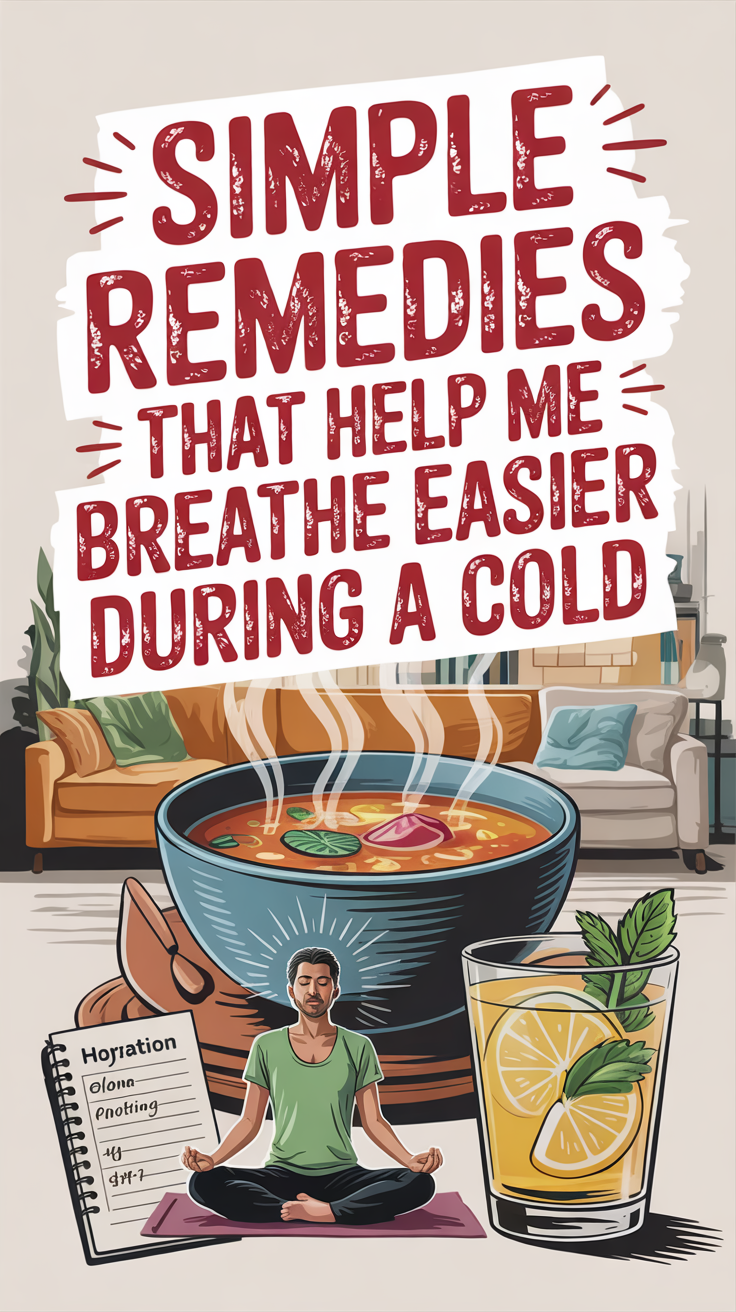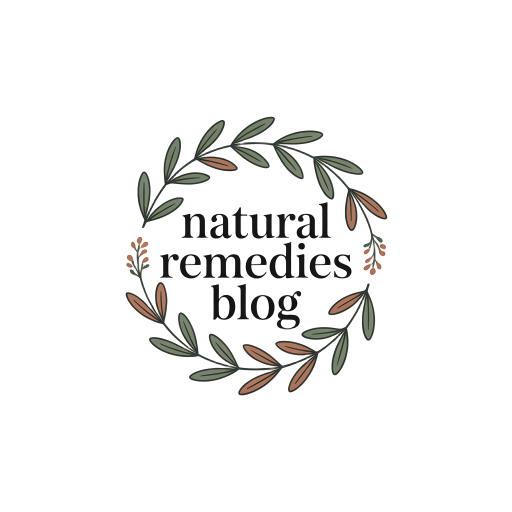Simple Remedies That Help Me Breathe Easier During a Cold
When you catch a cold, simple remedies can help you breathe easier. Try breathing techniques like pursed lip breathing or steam inhalation to relieve congestion. Stay hydrated by drinking warm liquids and consider using saline nasal sprays or a neti pot for effective nasal care. Incorporating a balanced diet rich in vitamin C will support your immune system. With these strategies, you’ll feel more comfortable and can explore additional tips for relief.
Breathing Techniques for Congestion Relief
How can you breathe easier during a cold? Try these breathing techniques as natural cold remedies to relieve congestion.
Start with pursed lip breathing—inhale through your nose for two seconds, then exhale slowly through pursed lips for twice as long. Repeat this for 5-10 cycles.
You can also practice nasal cycle breathing by alternating nostrils while focusing on diaphragmatic breaths. Additionally, blocked noses are commonly linked to colds, so these exercises can provide effective relief. Remember, natural decongestants like steam can enhance your ability to breathe more easily.
Furthermore, use the active cycle of breathing: take relaxed breaths, deep breaths held for three seconds, and finish with huffing exhalations.
Incorporating these techniques can dramatically improve your comfort and breathing efficiency during a cold.
The Benefits of Steam Inhalation
Steam inhalation offers you significant sinus relief by helping to clear mucus from your nasal passages. By adding aromatic oils, you can enhance the soothing effects, making the experience even more comforting. This simple practice not only eases congestion but also promotes overall respiratory wellness, allowing you to breathe easier during a cold. Additionally, steam inhalation has been linked to improved sleep quality, providing further benefits during your recovery. Furthermore, this method can hydrate airways and thin mucus, making it easier for your body to expel congestion.
Sinus Relief Benefits
When you’re battling a cold, finding effective relief for sinus discomfort can feel overwhelming. Steam inhalation offers soothing benefits, helping to open your nasal passages while reducing irritation and swelling. By inhaling steam, you can relieve congestion and soothe a sore throat, making breathing easier. It also aids in improving vocal cord mobility, which can be helpful if you’re experiencing hoarseness. Additionally, it loosens mucus in nasal passages, allowing for easier breathing and comfort during your recovery. Plus, the warm moisture reduces inflammation and promotes relaxation, ultimately improving sleep quality and supporting recovery. Keep your sessions brief and at a safe temperature for the best results without risking irritation or burns.
Enhanced Mucus Clearance
A common struggle during a cold is dealing with thick mucus that clogs your nasal passages, making it difficult to breathe comfortably. Steam inhalation offers a practical remedy. It hydrates and thins mucus, enhances ciliary activity, and reduces irritation. Additionally, experts note that it provides relief from respiratory ailments but is not a cure for infections like colds or flu. Try following this simple guide:
| Session Length | Sessions per Day | Benefits |
|---|---|---|
| 10–15 minutes | 2–4 | Supports mucus clearance |
| Eases nasal congestion | ||
| Safe for most ages | ||
| Non-pharmacological relief |
Incorporate steam inhalation into your routine for more effective breathing during your cold.
Comforting Aromatic Additions
Adding comforting aromatic elements to your steam inhalation can transform a simple session into a therapeutic experience.
Essential oils like eucalyptus and peppermint not only enhance relaxation but may also alleviate symptoms.
Menthol creates a cooling sensation that improves airflow, while lavender promotes stress relief and better sleep.
You might also consider tea tree oil for its mild anti-inflammatory benefits.
The pleasant scents can make you more likely to stick with your steam sessions, helping manage symptoms over time.
Just remember to keep safety in mind and enjoy the soothing effects as you breathe deeply.
Tools for Mucus Clearance
Effective tools for mucus clearance can make a significant difference in how you cope with congestion during a cold.
Here are four effective methods to try:
-
Humidify the air: Use a humidifier to keep mucus thin. A cool mist humidifier can operate throughout the day to help maintain moisture in the air. Maintaining optimal moisture is crucial for thinning thick secretions that contribute to congestion.
-
Saline nasal sprays: Rinse your nasal passages to relieve congestion quickly.
-
Steam inhalation: Inhale steam to loosen mucus in your lungs.
-
Coughing techniques: Practice controlled coughing to expel mucus naturally.
Incorporating these tools into your routine can significantly improve your breathing comfort, making those cold symptoms a bit more bearable.
Give them a shot!
Importance of Hydration and Nutrition
Hydration and nutrition are vital for your body’s ability to fight off a cold and recover quickly.
Staying hydrated thins mucus, relieving congestion and soothing a scratchy throat.
Drink plenty of water, juice, or broth while avoiding caffeinated and alcoholic beverages, as they can dehydrate you.
Prioritize a balanced diet rich in vitamins and minerals, particularly vitamin C, to support your immune system. Regular vitamin C supplementation can reduce cold duration significantly.
Remember, it’s better to focus on hydrating fluids rather than high-calorie drinks.
Regular fluid intake throughout the day will help maintain your energy and overall well-being during your cold, making recovery smoother and faster.
Effective Nasal Care Practices
Taking care of your nasal passages can make a big difference when you’ve got a cold.
Using saline sprays or practicing nasal irrigation can help clear congestion effectively, while comforting menthol salves provide added relief and a soothing sensation.
Applying pressure to pressure points can also enhance drainage and reduce inflammation in the nasal passages.
Let’s explore these effective practices to help you breathe easier.
Saline Spray Benefits
A saline spray can be a game-changer when you’re battling a cold, providing essential relief for nasal congestion.
Here are some key benefits:
- Thins mucus, making it easier to clear your nasal passages.
- Clears allergens and irritants through effective mechanical flushing.
- Moisturizes dry membranes, combating discomfort from a cold.
- Reduces inflammation, enhancing overall nasal function.
Use it frequently and consider applying it before medicated sprays for better absorption.
With its safe, non-pharmacological formula, saline spray not only alleviates symptoms but also shortens cold duration.
Breathe easier and stay comfortable with this simple remedy!
Nasal Irrigation Techniques
Nasal irrigation is an effective practice for maintaining nasal health, especially during a cold.
It alleviates sinus symptoms, clears mucus, and removes allergens from your nasal passages.
Using sterile or boiled water, mix salt and baking soda to create an isotonic saline solution.
Tilt your head and gently pour the solution through one nostril, letting it flow out the other.
Consider using a neti pot for ease.
Daily irrigation can significantly improve your breathing and reduce congestion.
Just be cautious not to overuse it and always clean your equipment thoroughly to avoid any risks.
Comforting Menthol Salves
For effective nasal care during a cold, mentoring your respiratory experience with comforting menthol salves can be beneficial.
These salves can relieve congestion and soothe your skin.
Try these methods for optimal results:
- Chest Application: Rub on your chest for deep menthol vapors.
- Nasal Area Application: Apply gently around the nose for moisture and relief.
- Foot Application: Use on feet at night to enhance symptom relief.
- Soothing Sore Throats: Topically apply to ease throat discomfort.
Embrace these remedies, integrating natural ingredients for a more pleasant recovery experience during your cold.
Rest and Comfort Strategies
To recover from a cold effectively, prioritizing rest and comfort is essential.
Aim for 8–10 hours of sleep each night and consider short daytime naps to recharge your body.
Avoid vigorous exercise for a few days to conserve energy for healing.
Elevate your head with extra pillows to reduce nasal congestion while you sleep.
Stay hydrated by drinking at least 8 cups of warm liquids daily, which can also soothe your throat.
Create a calm environment by using a cool-mist humidifier and keeping the room at a comfortable temperature to support your recovery efforts. Additionally, warm liquids such as herbal tea can provide antioxidants and calm coughs to further aid in recovery.
Natural Remedies for Easing Symptoms
When you’ve prioritized rest and created a comfortable environment to recover from a cold, it’s time to explore natural remedies that can ease your symptoms.
Here are four effective options:
- Warm Salt Water: Gargle to alleviate throat pain and congestion.
- Honey: Use in tea to soothe a cough and throat irritation.
- Steam Inhalation: Breathe in steam to loosen mucus and clear congestion.
- Ginger Tea: Drink to reduce inflammation, muscle pain, and nausea.
Incorporating these remedies can significantly enhance your comfort and help you breathe easier while you heal, as many ingredients like raw honey have proven antimicrobial properties that can complement your recovery.

